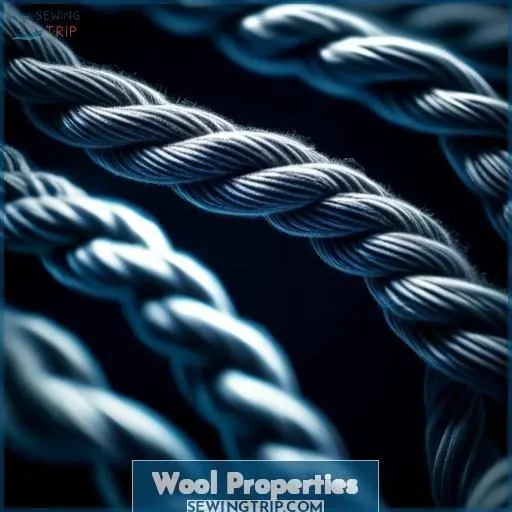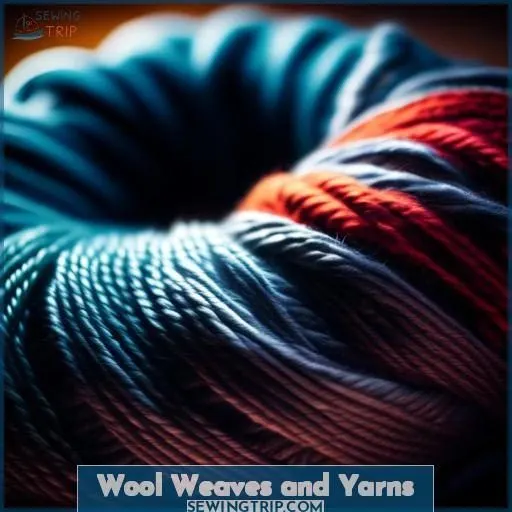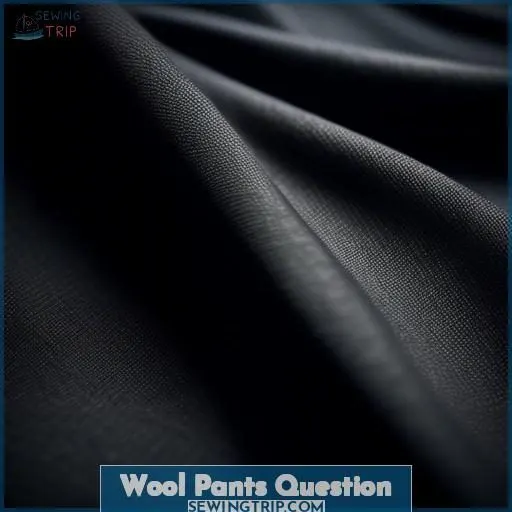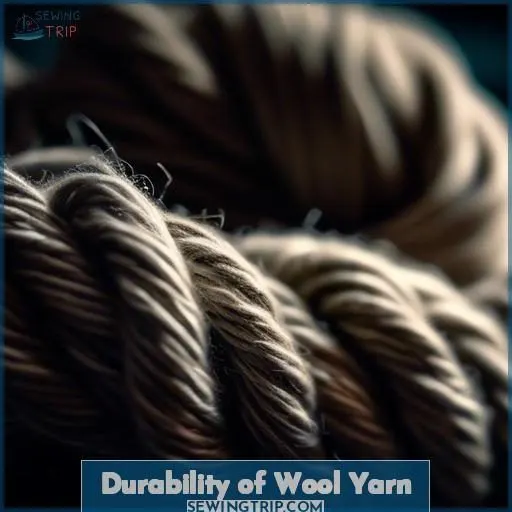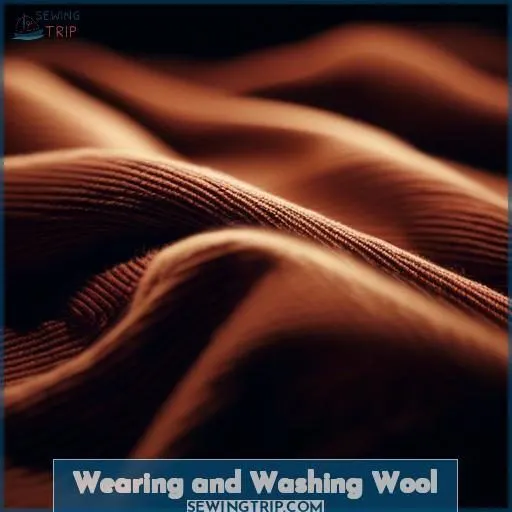This site is supported by our readers. We may earn a commission, at no cost to you, if you purchase through links.
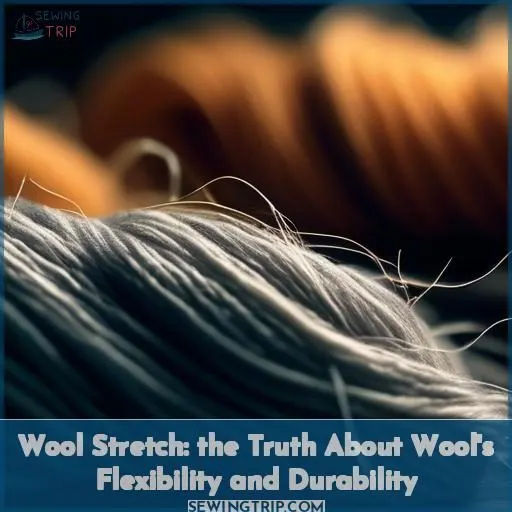
The degree to which wool stretches depends on the type of wool yarn and weave. Woolen fabrics tend to be more flexible and elastic, while worsted wool is less stretchy. However, wool’s natural stretch is limited – it doesn’t have the same level of stretchiness as synthetic fabrics.
The elasticity of wool pants is determined by the wool type, with merino wool being more flexible than other varieties. While wool doesn’t stretch substantially, it is a hardy, durable fabric that retains its shape well.
Table Of Contents
Key Takeaways
- Wool’s natural stretch is limited, but it varies depending on the type of wool yarn and weave.
- Merino wool is more flexible than other varieties, offering some stretch for pants.
- Wool pants should fit well from the start and maintain their shape over time with proper care.
- Wool yarn’s durability is influenced by its twist, quality, and care instructions.
Does Wool Stretch?
Yes, wool can stretch, especially when wet, and it may become slightly roomier with regular wear. However, the extent of stretching depends on the wool’s fiber, yarn elasticity, and knit tightness.
Wool Properties
Let’s explore the realm of wool, a fabric that’s as multifaceted as it’s misapprehended. Contrary to common perception, wool’s elasticity is a transformative quality, providing resilience that exceeds your expectations.
Nurturing wool is akin to fostering a friendship; it demands care but reciprocates with longevity. Whether it’s the tenacity of merino wool or the adaptability of wool fibers, comprehending wool’s distinct attributes guarantees that your garments retain their pristine condition, extending to accommodate your life without compromising their form.
Wool Weaves and Yarns
Wool weaves and yarns play a vital role in defining the elasticity and resilience of wool garments. Woolen yarns, crafted from shorter fibers of the sheep’s fleece, are softer, lighter, and more flexible than worsted yarns. Woolen yarns are perfect for creating thick, heavyweight woven or knitted garments, such as blankets, scarves, and coats.
Conversely, worsted yarns are smoother, shine more easily, and maintain their shape. They’re made from long-staple pasture wool from sheep breeds like Teeswaters, Old Leicester Longwool, and Romney Marsh. The worsted process involves combing the short hairs out of the fiber, resulting in a hard finish on the surface.
Woolen flannel trousers, made with woolen yarns, may sag at the knees due to the loose fibers and minimal twist during spinning. In contrast, hard worsted wool, such as that used in suits, stretches minimally or not at all.
When it comes to wool pants, the type of yarn and weave can have a substantial impact on their elasticity and durability. Coarse wool tweed with woolen yarns can adjust over time, while hard worsted wool pants may not stretch at all. Wool pants should fit well from the start, as they may stretch slightly if worn and laundered frequently.
When considering wool pants, it’s crucial to understand the distinctions between woolen and worsted yarns to make an informed decision based on your desired level of elasticity and resilience.
Wool Pants Question
Wool pants are a sought-after item in men’s closets because of their hardiness and flexibility. However, the ability of wool pants to stretch is a concern for many shoppers. While wool is renowned for its sturdiness and elasticity, it doesn’t stretch like other materials. Here are some crucial points to remember when buying wool pants:
- Wool types: Different kinds of wool, such as merino, have varying levels of elasticity. Merino wool, for example, has a slight stretch that can accommodate movement and wear.
- Stretch limits: Wool pants aren’t designed to stretch substantially. They’re meant to fit well initially and maintain their shape over time.
- Care instructions: Proper care is essential for maintaining the shape and longevity of wool pants. Handwashing is advised for most wool garments, and it’s imperative to avoid exposing them to direct sunlight or heat sources, as these can cause shrinkage or damage.
- Fitting tips: Wool pants should fit well from the start, as they’re unlikely to stretch notably over time. This means selecting the correct size and ensuring a comfortable fit without being too tight.
- Wear patterns: Wool pants may conform to the wearer’s body over time, but they aren’t meant to be stretched out of shape. They’ll maintain their shape and structure best when worn and cared for properly.
Durability of Wool Yarn
Wool yarn’s durability is influenced by its twist and quality. Two-ply yarn is superior to single-ply, as the ply twist counteracts the torque in single yarn.
Lanolin-rich wool is more weather-resistant, and treated wool may possess altered properties. Wool yarn’s durability also depends on the wear and care it receives.
Wool doesn’t stretch, but may tear at seams. Wool pants should fit well from the start.
Wool yarn’s form and shrinkage can be influenced by chemical treatments and washing instructions.
Wearing and Washing Wool
To maintain your wool garments’ flexibility and durability, consider these guidelines:
- Shrinkage prevention: Wash wool sweaters in cold water and avoid over-wringing to prevent shrinkage.
- Lanolin preservation: Wool naturally contains lanolin, which provides weather resistance. Washing removes it, so dry your sweaters naturally to preserve this property.
- Knit tightness: Tightly knitted wool sweaters are less prone to shrinkage.
- Water resistance: Washing and reshaping your wool sweaters help maintain their water resistance.
- Comfortable fit: Wool sweaters conform to your shape, so make sure they fit well from the start.
For cotton sweaters, buy them on the snug side, wash in cold water, hang to dry, and iron on low heat. By following these tips, you’ll keep your wool garments comfortable, stretchy, and long-lasting.
Frequently Asked Questions (FAQs)
How does wool react to different climates?
Wool’s dance with climate is an enthralling tango – it swells up in humid weather, shrivels in dry air, and practically does the splits in extreme temperatures! Your cozy companion is a true weather chameleon.
Can wool garments be altered for a better fit?
Wool can be adjusted to fit you like a glove. Just take it to a skilled seamster – they’ll work their magic, nipping and tucking until it’s perfect. No need to endure a baggy bottom!
What are the environmental impacts of wool production?
The wool industry’s environmental impact is complex – from water usage to greenhouse gas emissions. But by choosing responsibly-sourced wool, you can minimize your footprint and enjoy wool’s natural, renewable benefits. It’s a thoughtful balance worth exploring.
How does the color of wool affect its care?
The color of wool influences its care – lighter shades may require more delicate handling to preserve their vibrancy, while deeper hues can withstand harsher cleaning methods. Consider fiber content and weave when selecting the best care routine.
Are there any hypoallergenic properties of wool?
Did you know wool contains lanolin, a natural oil that can soothe irritated skin? It’s a hypoallergenic fiber that’s gentle on sensitive types, so you can comfortably wrap yourself in its cozy embrace.
Conclusion
Ultimately, you’ve learned that while wool doesn’t stretch like synthetic fabrics, its natural elasticity varies depending on the type.
Merino wool, for instance, offers excellent flexibility for pants.
However, wool’s real strength lies in its durability – quality wool yarn retains its shape remarkably well over time with proper care.
So regarding the question of whether wool stretches, the answer is a nuanced one determined by the specific wool variety and construction.

